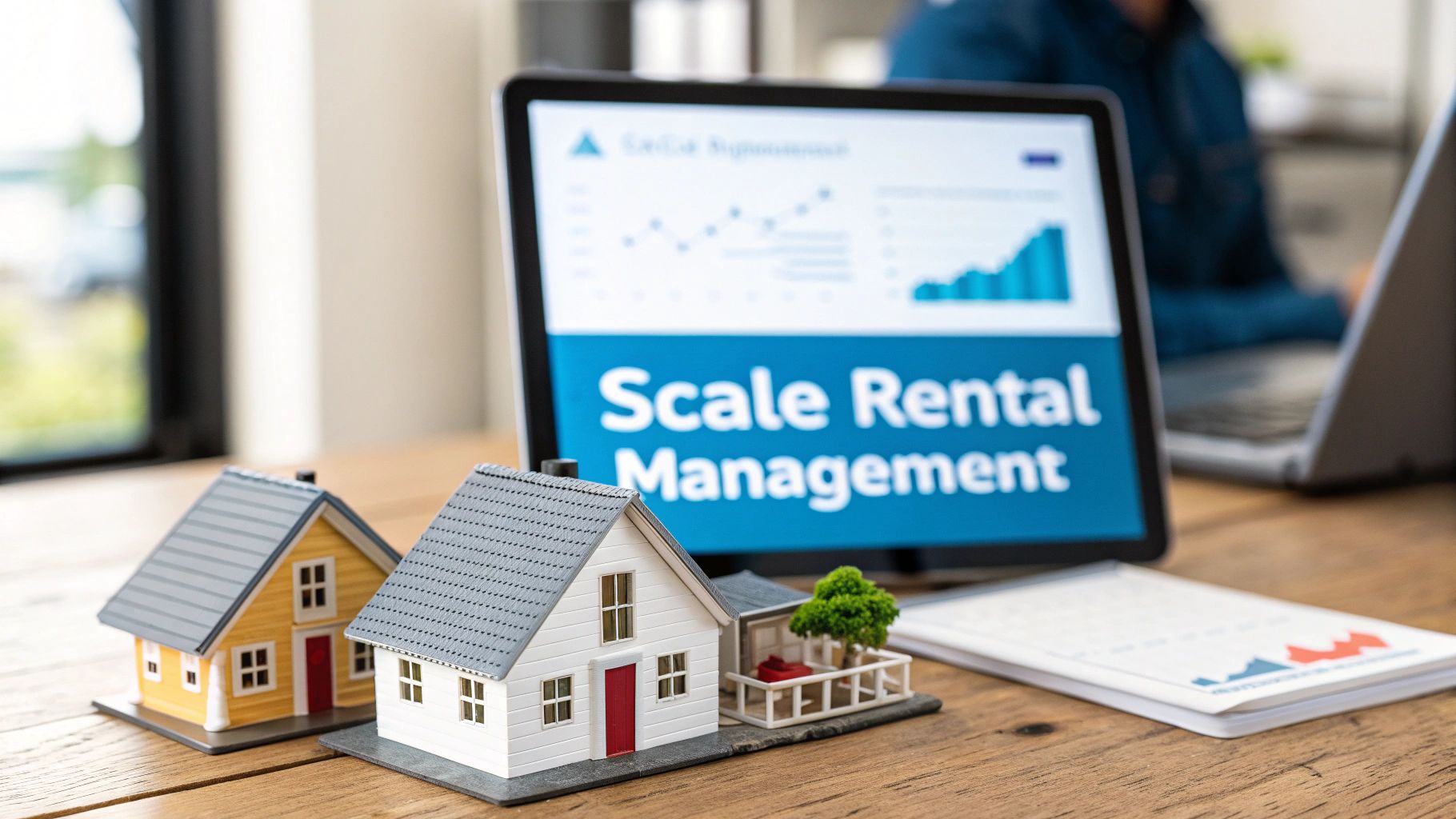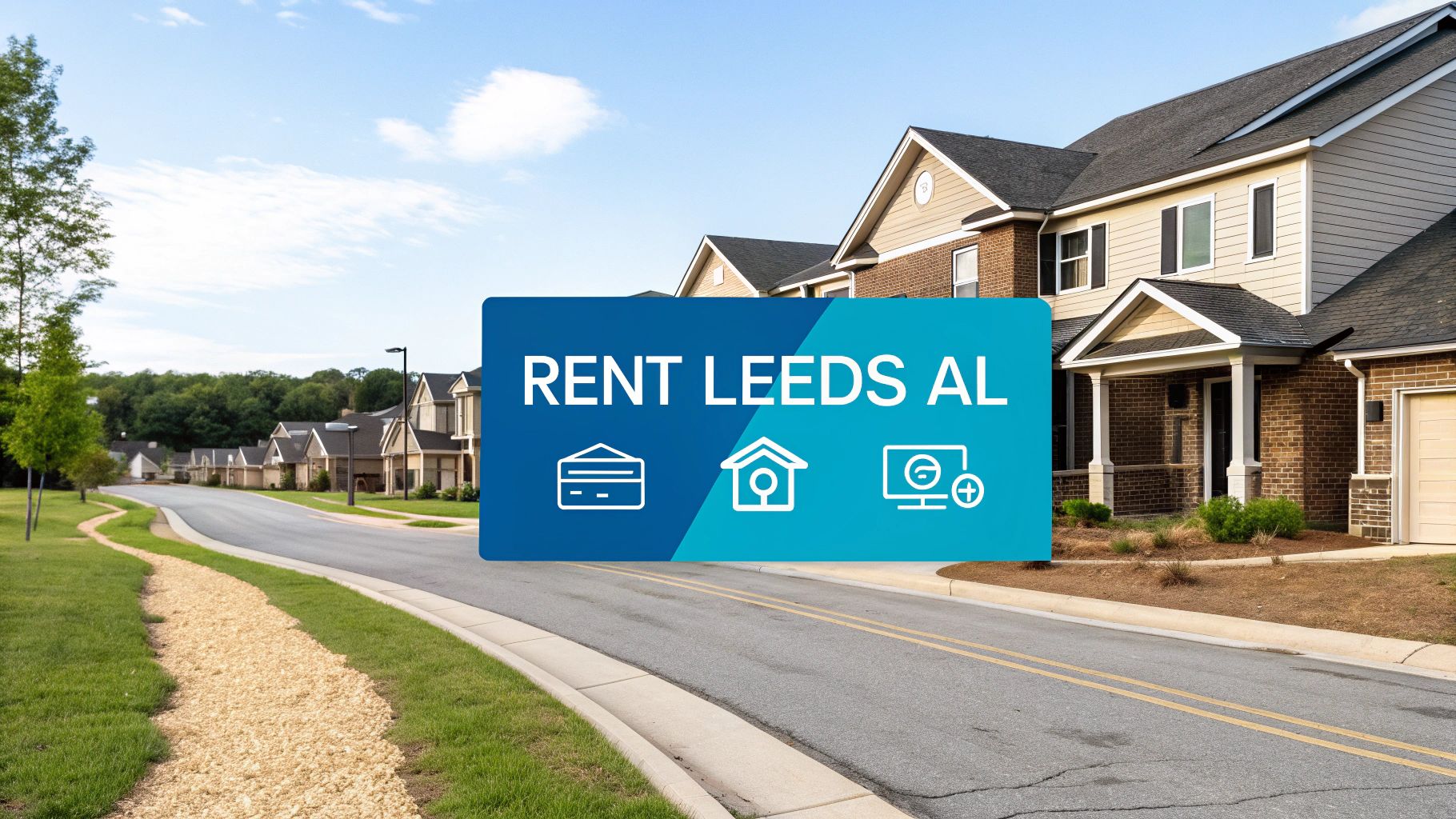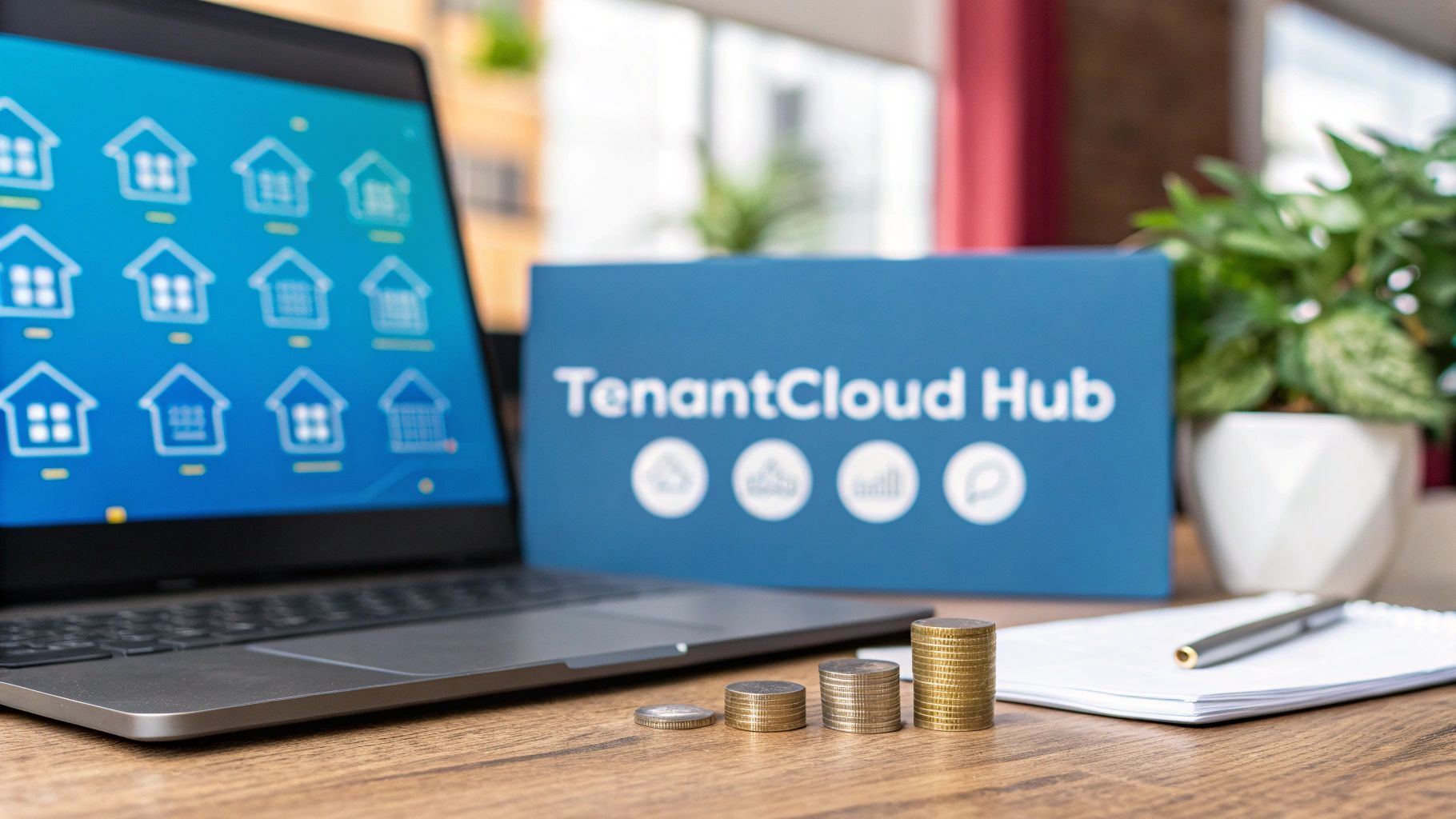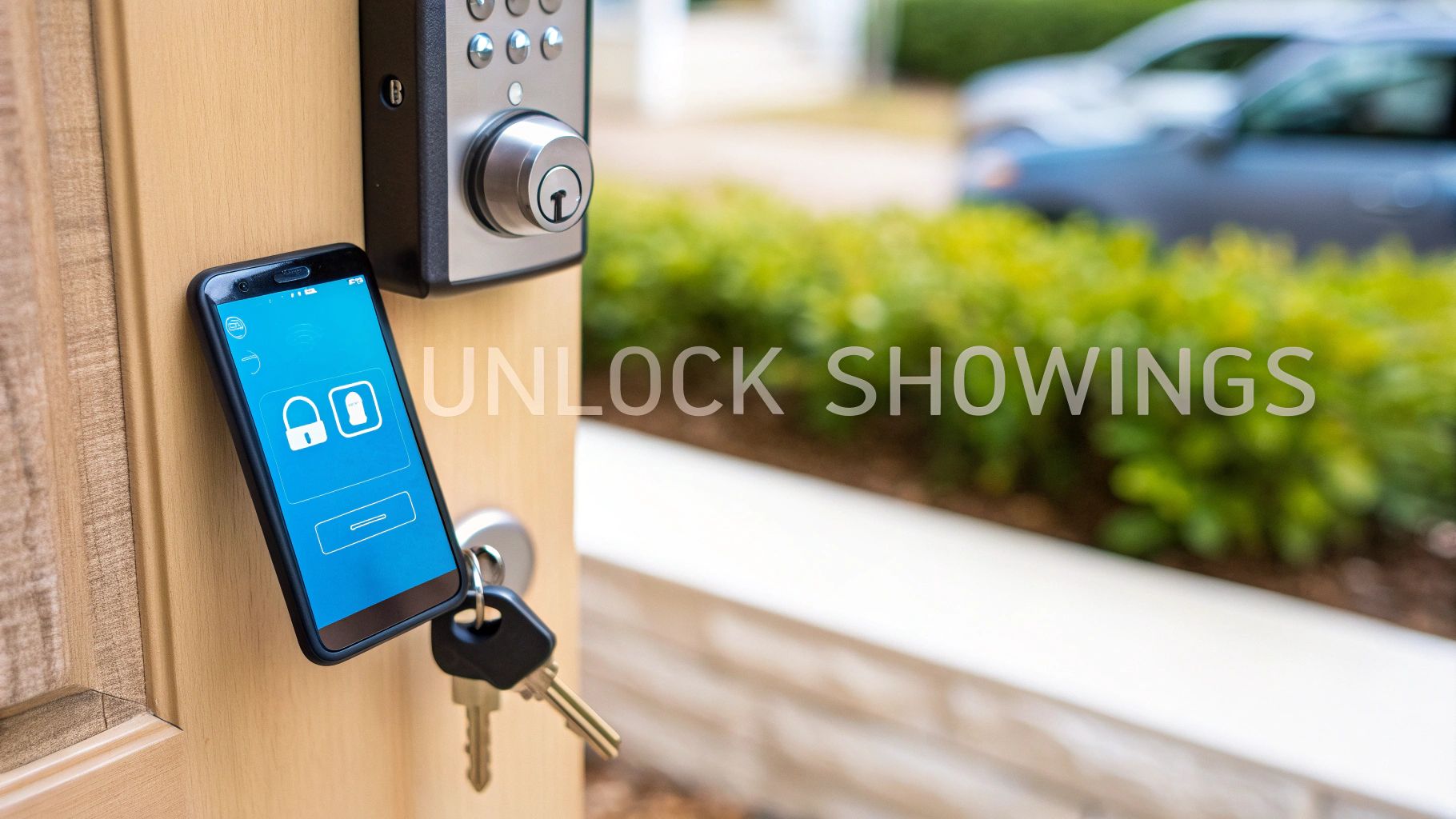Effective rental homes management isn’t just about collecting rent and fixing leaky faucets. For enterprise-level operators, it's a strategic, data-driven operation that transforms a portfolio of properties into a high-performing asset. Think of it as the engine that powers everything from lead conversion to lease signing—all with the goal of boosting your net operating income (NOI) by minimizing vacancy loss and maximizing operational efficiency.
The New Rules of Enterprise Rental Homes Management
Managing a portfolio of 1,000+ rental homes isn't just a bigger version of managing fifty. It’s a completely different ballgame that demands a new set of rules. The manual, hands-on methods that work for a small portfolio will absolutely collapse when you try to scale them across thousands of units in different markets. The operational complexity doesn't just grow; it multiplies, and so does the financial risk.
At the enterprise level, management has to shift from a reactive, task-based mindset to a proactive, systems-driven strategy. The focus is no longer on individual properties but on optimizing the entire leasing funnel for maximum speed and efficiency. Every decision gets measured by its impact on key performance indicators (KPIs) like Days on Market (DOM), lead-to-tour conversion rates, and your cost per door.
The infographic below breaks down just how different these two worlds are.
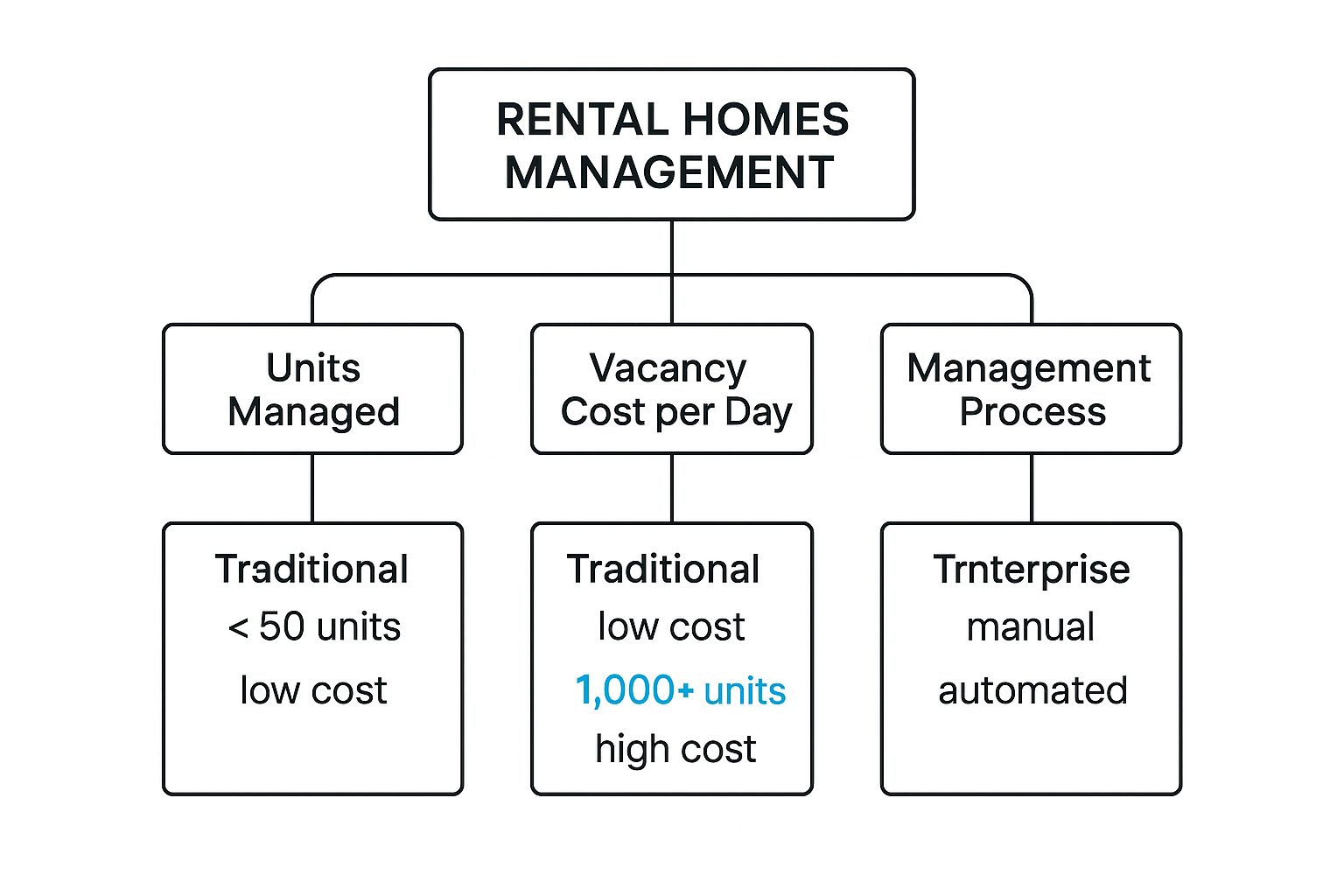
As you can see, the cost of a vacant property skyrockets as a portfolio grows. This makes tech-powered, automated processes not just a nice-to-have, but a mission-critical component for profitability and scale.
Core Challenges for Large Portfolios
For large-scale operators, the usual pain points are magnified and carry serious financial weight. The chaos of trying to coordinate tours across a scattered portfolio, ensure every lead gets an instant follow-up, and manage remote operations without on-site staff can lead to crippling slowdowns and significant revenue loss.
The real challenge isn't just managing properties; it's managing the immense volume of data, leads, and tasks with precision. A single dropped lead or a two-day delay in scheduling a tour can cost thousands in lost revenue when multiplied across a large portfolio. Every vacant day is a direct hit to your NOI.
This operational friction hits your bottom line directly. Slow response times and scheduling headaches mean qualified leads will just go to your competitors, pushing up vacancy rates and marketing spend. To fight back, modern operators are adopting a technology-first mindset.
The shift toward enterprise-level property management is undeniable. The old ways just can't keep up with the demands of managing thousands of doors. The table below illustrates the fundamental operational shifts required when scaling from a small-time operation to a large-scale enterprise.
Modern vs Traditional Rental Management Approaches
This comparison makes it clear: what works for a handful of properties becomes a bottleneck at scale. Enterprise success hinges on building systems that are efficient, repeatable, and scalable.
Technology is completely reshaping rental home management across the globe. According to Zillow's 2024 Consumer Housing Trends Report, 77% of renters find it important to be able to apply for a rental online. This demand for digital convenience is a clear signal that the industry must evolve.
The future of property management at scale is all about building smarter systems, not just hiring more people. To get a better handle on this evolution, you might want to explore our insights on the future of property management. This new playbook requires a serious commitment to automation and data if you want to achieve predictable, scalable results.
The Three Pillars of a Scalable Leasing Funnel
For property managers overseeing large-scale rental homes management, the leasing funnel isn't just another workflow—it's a high-stakes production line. When you're managing thousands of doors, even a tiny crack in this system can spring a massive revenue leak. A truly scalable operation is built on three distinct pillars, and getting each one right is the key to portfolio-wide profitability.
A weak link in this chain doesn't just create delays. It directly inflates your Days on Market (DOM), kills your lead-to-tour conversion rates, and sends your cost-per-lease skyrocketing. At the enterprise level, the pressure is intense. A disorganized funnel can be the difference between signing a lease in 15 days versus 30—a gap that costs thousands daily across a large portfolio.
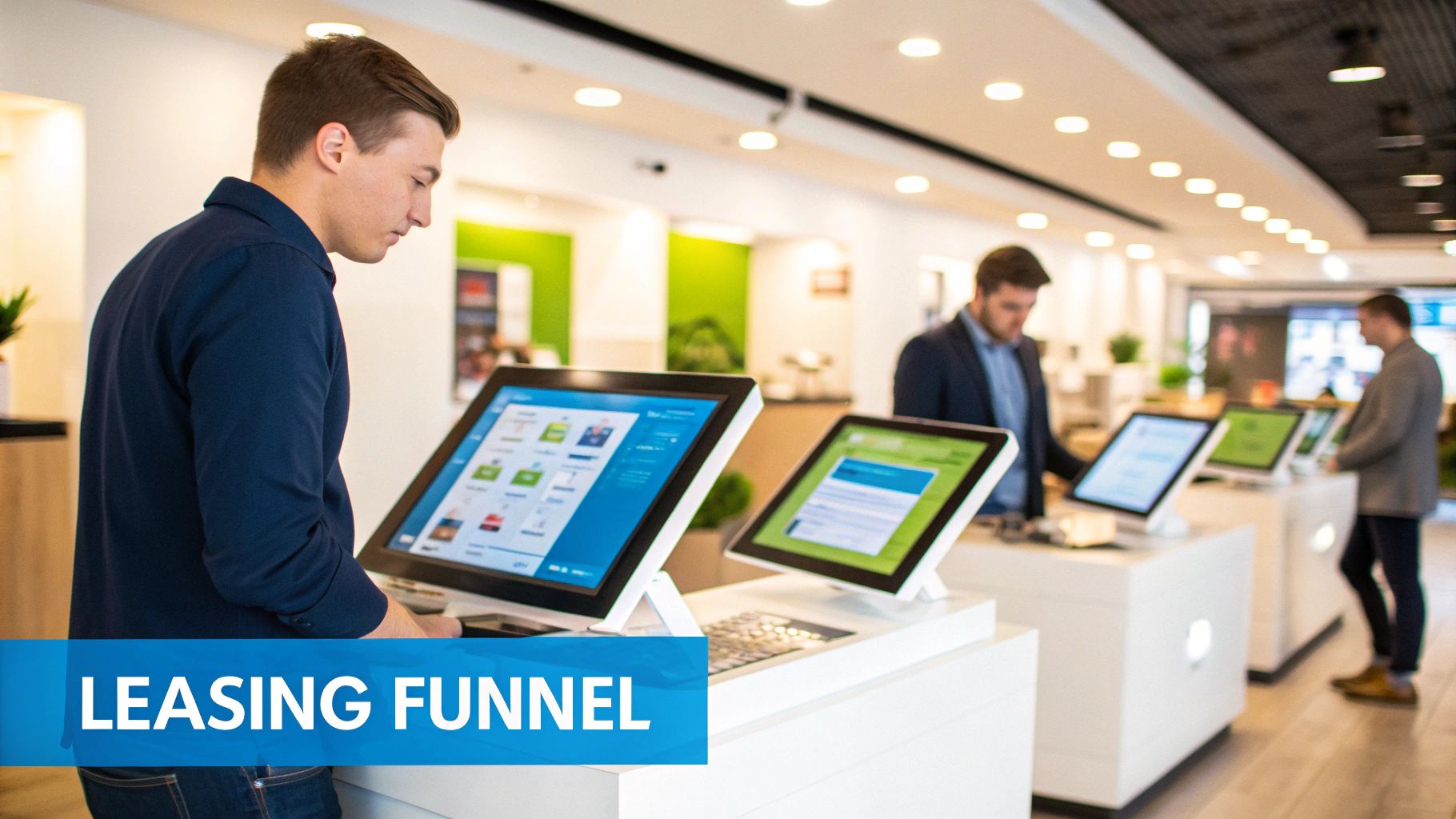
Pillar 1: Lead Management
At scale, lead management feels less like nurturing prospects and more like controlling a firehose without getting soaked. When your portfolio is pulling in thousands of leads a month from every listing site under the sun, the real challenge is to instantly qualify and engage the best ones before they ghost you. Manual follow-up isn't just inefficient; it's a guaranteed way to lose money.
The name of the game is speed and consistency. Every minute a serious renter waits for a response, their interest is fading. To win, you need an automated system that can:
- Instantly Respond: Acknowledge every single inquiry within seconds, 24/7.
- Pre-Qualify Prospects: Use smart, automated questions to filter for renters who actually meet your criteria.
- Centralize Communication: Funnel all interactions into one clean dashboard so nothing ever falls through the cracks.
A slow lead response is the fastest way to lose a qualified renter. If you can't engage them within the first five minutes, your chances of converting them to a tour drop dramatically. At an enterprise level, this is a multi-million dollar problem.
Pillar 2: Tour Coordination
This is where things usually get messy, especially for distributed portfolios. How do you efficiently schedule and run hundreds of tours across multiple states, particularly when you don't have dedicated staff at every property? The logistical headache of matching a prospect’s availability with an agent's schedule is a direct cause of high DOM.
Great tour coordination is all about flexibility and access. The easier you make it for someone to see a property on their terms, the faster you'll get that lease signed. This means ditching the old 9-to-5 showing window for good. The best systems offer:
- On-Demand Scheduling: Let prospects book same-day or next-day tours right from their phone.
- Self-Service Options: Give renters the freedom to tour on their own with secure, self-guided tours.
- A Flexible Workforce: Tap into a network of on-demand agents to cover showings on evenings, weekends, and at the last minute.
To get your funnel running like a well-oiled machine, it helps to borrow proven sales funnel optimization strategies and adapt them to the unique world of rental properties.
Pillar 3: Application Processing
The final pillar is all about closing the deal. You need to convert a great tour into a signed lease as quickly as humanly possible. A clunky, slow application process will make even the most excited prospects walk away. At this stage, friction is your worst enemy. Every extra step or delay gives the applicant time to find another place.
The key here is a seamless, digital experience. Your system has to be fast, transparent, and mobile-friendly. A modern application process should include:
- Digital Applications: Simple online forms that can be filled out from anywhere, on any device.
- Automated Screening: Instant background and credit checks that speed up your decision-making.
- E-Signatures: Secure, digital lease signing that gets rid of the need for in-person appointments.
By fortifying these three pillars, property managers can build a leasing machine that operates with predictable speed and efficiency. You can learn more about how to optimize your leasing funnel to slash DOM and boost revenue. Ultimately, a strong funnel transforms rental homes management from a chaotic, reactive process into a scalable, data-driven operation.
Calculating the Real Cost of Leasing Inefficiency
Every day a property sits empty, it’s a direct, painful hit to your bottom line.
For property managers juggling thousands of units, leasing inefficiency isn't just an operational headache—it's a multi-million-dollar problem hiding in plain sight. Translating this friction into hard numbers is the only way to reframe operational improvements from a "cost center" into a high-return investment.
To really get a grip on managing rental homes at scale, you have to look past simple occupancy rates. The metric that truly defines profitability is the cost of vacancy. This number reveals the financial damage of every single day a unit stays empty, a figure that becomes staggering when you multiply it across a large portfolio.
The Math Behind Vacancy Loss
The formula itself is simple, but its implications are massive. First, figure out the daily rental value for one of your average units. If the average monthly rent is $1,800, the daily loss is a clean $60 ($1,800 / 30 days).
Now, let's blow that up to the portfolio level. A 2,000-unit portfolio with a modest 5% vacancy rate has 100 empty units at any given moment. The math is brutal:
100 vacant units x $60/day = $6,000 in lost revenue. Every. Single. Day.
That number quickly spirals to $180,000 per month and balloons to over $2.1 million per year in pure revenue loss. This isn't some theoretical figure; it's real cash flow evaporating because of operational drag in your leasing funnel.
Uncovering the Hidden Costs
The direct loss of rent is just the tip of the iceberg. True leasing inefficiency creates a ripple effect of secondary costs that quietly eat away at your Net Operating Income (NOI). These hidden drains often go untracked but are just as damaging.
- Slow Lead Response: Every hour you make a lead wait for a reply, their interest cools. Lost leads mean you have to spend more on marketing just to get back to where you started.
- Scheduling Friction: A clunky tour scheduling process doesn't just frustrate prospects; it gives them time to go find and lease a competitor's property.
- Wasted Marketing Dollars: You spend your marketing budget to generate leads. If your team can't convert them because of operational bottlenecks, that investment is completely wasted.
- Turnover Expenses: Each day a unit is vacant, you’re still on the hook for carrying costs like utilities, insurance, and property taxes—all without any rental income to offset them.
The rental market just keeps growing, with the U.S. property management industry expected to hit $134.2 billion in revenue. This boom is fueled by housing affordability issues that keep rental demand high. But even with that demand, the national rental vacancy rate was 6.6% in the first quarter of 2024, according to the U.S. Census Bureau, proving that simply having demand doesn’t fill a unit if your management isn't efficient. You can dive deeper into these trends with IBISWorld's comprehensive analysis of the property management market.
The table below gives a clear snapshot of how quickly these vacancy costs pile up across a large portfolio, hammering home just how urgent it is to shrink your Days on Market.
Daily Vacancy Cost Analysis for a 2,000-Unit Portfolio
When you look at it this way, the conclusion is clear. Even a one-day reduction in your average DOM can save hundreds of thousands of dollars a year. Every operational improvement you make is a direct investment back into your portfolio’s profitability.
Building Your Enterprise PropTech Stack
For any rental homes management operation looking to scale, your technology is the backbone. Patching together a random collection of software just won't cut it when you're managing a large portfolio. It actually creates more problems. To really empower remote management and drive automation across thousands of units, you need a powerful, integrated PropTech stack.
Think of it like an orchestra. Each software is an instrument. For them to work together in harmony, they need a conductor and a shared sheet of music. Without that integration, all you get is a chaotic mess of disconnected data, endless manual entry, and seriously frustrated teams.
The Core Components of a Modern Stack
A high-performance PropTech stack really boils down to three critical pieces. Each has its own job, but their true power is only unlocked when they work together as one cohesive system.
Property Management System (PMS): This is your operational conductor. Your PMS (think AppFolio, RentManager, or Buildium) is the central source of truth for your entire portfolio. It handles the heavy lifting like accounting, maintenance requests, and core property data. Every other system you use should feed data into and pull from your PMS.
Customer Relationship Management (CRM): While a PMS manages the properties, a CRM manages the people—your prospects, tenants, and owners. It’s the system that tracks every single interaction, from the first time someone inquires about a unit all the way through to their renewal, giving you a complete history of every conversation.
Leasing Automation Platforms: These are the specialists. Tools like Showdigs plug right into your leasing funnel to dramatically speed up the time it takes to sign a lease. They automate the most time-sucking parts of the process—like responding to leads, scheduling tours, and dispatching agents—which has a direct impact on your days on market and lead-to-tour conversion rates.
The global property management market is expected to hit nearly $28 billion by 2028. Here in the U.S., it's projected to grow to $98.88 billion by 2029. With roughly 35% of property managers overseeing 101 to 500 units and the biggest firms managing over 798,000, the scale of these operations is just massive. Integrated technology isn't a luxury; it's non-negotiable.
The Power of Seamless Integration
Integration is what turns a bunch of separate software tools into a single, unified operational machine. This magic usually happens through Application Programming Interfaces (APIs), which act like secure bridges that let different systems talk to each other automatically.
A well-integrated stack means that when a prospect fills out a form on your website, their info instantly populates in your CRM, your leasing platform, and your PMS—all without anyone lifting a finger. This is the bedrock of scalable remote management.
This seamless flow of data gets rid of manual entry, slashes human error, and gives your team a real-time view of the entire leasing pipeline. It lets you standardize your process across different markets and make smart, data-driven decisions based on what's happening right now.
To make a modern PropTech stack work, you have to know how to handle real-time data. For those who want to geek out on the technical side, checking out A Practical Guide to Real-Time Data Streaming can offer some great insights into how today’s systems stay so perfectly in sync.
Choosing the Right Tools for Scale
When you’re picking out tech for a large portfolio, always prioritize solutions built for integration and automation. Look for platforms with open APIs and existing partnerships with the major PMS providers. The goal is to create a system where data flows effortlessly from that first website click to the final lease signature.
Modern leasing platforms are also getting smarter by using artificial intelligence to make workflows even smoother. By automating tasks like pre-screening leads and scheduling showings, these systems free up your team to focus on high-value, revenue-generating activities. You can see what’s out there by exploring some of the best AI-powered property management tools.
Ultimately, the right PropTech stack gives you a single dashboard to manage a huge, distributed portfolio, turning what could be operational chaos into a real competitive advantage.
Proven Strategies to Drastically Reduce DOM
Knowing the theory is one thing, but putting it into action is how successful rental homes management operations get ahead. To really speed up your leasing cycle and slash your Days on Market (DOM), you need battle-tested strategies that get real results. Just having a great property isn’t enough anymore; you have to master the art of turning a curious browser into a signed tenant—faster than everyone else.
The best tactics all boil down to one thing: removing friction for serious renters. Today's renters expect things to happen instantly. Any delay in your process is basically an invitation for them to go check out the competition. A slow, manual leasing funnel isn't just inefficient; it's actively costing you money.

Strategy 1: Deploy 24/7 Instant Lead Response
The moment a potential tenant shows interest is the most important part of the entire journey. If your team can't respond right away, you're already losing. An AI-driven, automated lead response system makes sure every single inquiry gets a helpful reply in seconds, whether it's 2 PM or 2 AM.
And this isn't just about a generic "we'll get back to you" email. A smart system can pre-qualify prospects with a few quick questions, answer the common stuff, and immediately point qualified renters to the next logical step: booking a tour.
For a 3,000-unit portfolio, even a five-minute delay in responding to a lead can mean losing dozens of qualified renters every single week. An automated system that engages instantly captures that revenue instead of letting it slip away.
Strategy 2: Offer On-Demand and Same-Day Tours
The renters who are most likely to sign a lease want to see a property now. When you offer same-day and on-demand tour scheduling, you're meeting that urgency head-on. This strategy catches motivated prospects when their interest is at its absolute peak, which dramatically shortens the time between their first click and an in-person visit.
It's time to eliminate the endless email chains and phone tag that kill so many deals. Give prospects a simple online calendar where they can book a tour that works for them, even if it's on an evening or weekend when your office is closed. That level of convenience is a huge competitive advantage.
Strategy 3: Leverage a Flexible Showing Agent Network
Trying to staff for peak leasing season across a spread-out portfolio is a logistical nightmare. Instead of relying only on your in-house team, tapping into a flexible network of on-demand showing agents gives you incredible scalability and coverage.
This approach means you can cover hundreds of tours across different markets without the massive overhead of a full-time payroll. A flexible workforce lets you say "yes" to almost every tour request, getting more eyes on your property and boosting your lead-to-tour conversion rates. For any serious rental homes management operation focused on speed, this model is a game-changer.
Think of it as a three-pronged attack on vacancies:
- AI-Powered Engagement: Use automation to instantly qualify and chat with leads around the clock, so no one is left waiting.
- Self-Service Scheduling: Let renters book tours on their own time. This removes a huge administrative bottleneck and gets them in the door faster.
- Scalable Field Services: Tap into a network of professional agents to offer maximum tour availability, turning every inquiry into a potential viewing.
Real-World Impact:
A large property management company was overseeing 4,000 single-family rentals and struggling with an average DOM of 30 days. Their leasing team was completely swamped, and the friction in their scheduling process was causing them to lose good leads.
They decided to implement an automated lead response system and bring in an on-demand network of showing agents. Almost overnight, they were offering same-day tours and instant scheduling confirmations. The results were immediate and powerful. Their average DOM plummeted from 30 days to just 16. They effectively cut their vacancy time in half and added hundreds of thousands in annual revenue back to their bottom line. This just goes to show that investing in speed and convenience isn't a cost—it's a direct path to being more profitable.
A Real-World Framework for Scaling Up
Switching your rental homes management from a manual, put-out-the-fires model to an automated, forward-thinking system isn't something you do overnight. For busy operations directors managing huge portfolios, trying to change everything at once is a recipe for disaster that could mess with your cash flow.
Instead, a phased approach is the only sane way to get it done. The goal here isn't just to buy some new software. It's to completely rebuild your leasing funnel to be faster and more efficient from the ground up. True scale comes from smarter systems, not just from hiring more people to patch up the old ones.
Phase 1: Audit and Analyze
You can't fix what you don't measure. The first step is all about getting a brutally honest look at your current leasing performance. This creates the baseline you’ll use later to show everyone just how much of a difference your changes made. Don't be tempted to skip this part.
Get laser-focused on your most important leasing numbers:
- Calculate Your Current DOM: What’s the average number of days a unit sits empty, from the moment it’s vacant to when a new lease is signed? No sugarcoating.
- Track Lead-to-Tour Conversion: Out of all the good leads you get, how many actually end up touring a property? This number tells you exactly where the friction is in your scheduling process.
- Figure Out Your Cost Per Lease: Add up your marketing spend, staff time, and the cost of vacancy to see what it really costs to fill a unit.
Phase 2: Integrate and Automate
Once you have your numbers, you can start strategically rolling out your technology. This phase is about connecting your systems and killing off the most soul-crushing, repetitive tasks that are bogging down your leasing team.
A great place to start is by integrating a leasing automation platform like Showdigs with your existing Property Management System (PMS). This gets your data flowing smoothly between systems, cutting out manual data entry and making sure everyone is looking at the same information. Once they're connected, you can flip the switch on automated workflows for things like instant lead responses, 24/7 tour scheduling, and dispatching agents to properties.
Phase 3: Standardize and Optimize
The final step is to take your new, automated system and roll it out across your entire portfolio. This is where you create a single, standardized leasing process so that every lead, no matter the market, gets the same lightning-fast, professional experience.
The real endgame here is predictability. When you have a standardized, automated system, you can forecast vacancy periods, manage costs, and drive higher net operating income with a whole lot more confidence. Scaling isn’t about making your team work harder; it’s about building an operational machine that works smarter.
By walking through this framework step-by-step, you can systematically unclog bottlenecks, slash your Days on Market, and build a leasing operation that’s actually ready to grow.
Frequently Asked Questions About Scaling Management
Making the leap to a more automated, scalable model for rental homes management always brings up some big questions, especially for enterprise-level operators. Let's dig into a few of the most common ones we hear from decision-makers thinking about shaking up their leasing operations.
How Do New Leasing Platforms Integrate With Our Existing PMS?
This is usually the first and most important question for any large operator. The good news is that modern leasing automation platforms are built to play nicely with others. They use APIs (Application Programming Interfaces) to create a direct link with major Property Management Systems like AppFolio, RentManager, or Buildium.
Think of it as creating a two-way street for your data. New lead info gets automatically pushed into your PMS, and your property availability is pulled out in real-time. The whole point is to kill manual data entry, stop errors before they happen, and make sure everyone is working from the same playbook.
What Is the Realistic ROI of Automating Our Leasing Funnel?
The return on investment really boils down to two things: slashing vacancy costs and making your team more efficient. The math is pretty straightforward. First, figure out what vacancy is costing you now based on your average Days on Market (DOM).
Then, see what happens when you shave just a few days off that number. For a 2,000-unit portfolio with an average rent of $1,800, cutting DOM by just five days can save $300,000 annually in lost rent alone. That's a huge number, and it doesn't even count the money you save by freeing up your team from chasing leads and scheduling tours all day.
Most large portfolios find that an automated leasing system pays for itself within the first few months. It's simple: you convert leads faster and get leases signed sooner.
How Can We Maintain Brand Standards Across Multiple Markets?
Keeping the renter experience consistent and high-quality is a huge deal when you operate in more than one city. A centralized leasing platform is the answer here. It lets you standardize the entire journey, from the first time a prospect contacts you to the moment they finish a tour.
Here’s how it helps you keep everything consistent:
- Standardized Communication: Automated messages mean every single prospect gets the same professional, on-brand follow-up. No more guesswork.
- Uniform Tour Experience: Whether you’re using on-demand agents or self-showings, you can set the exact same rules and checklists for every tour at every property.
- Centralized Oversight: A single dashboard gives you a bird's-eye view of every interaction. You can see what’s working, what isn't, and enforce your brand standards from one place.
This approach guarantees that a prospect in one city has the exact same great experience as someone a thousand miles away, which is crucial for protecting your brand as you grow.
Ready to see how much you could save by cutting your Days on Market? Showdigs provides the AI-backed leasing automation platform and on-demand agent network to help you turn leads into leases faster than ever. Schedule a demo today and build a more profitable leasing operation.




